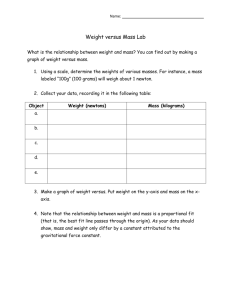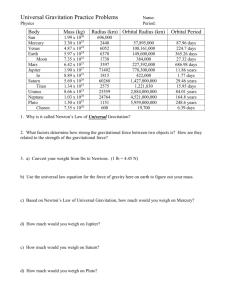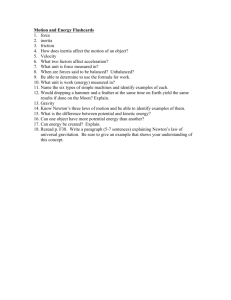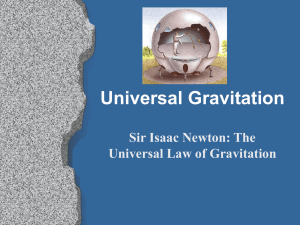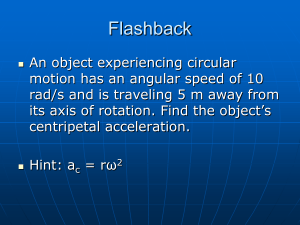File - SPHS Devil Physics
advertisement
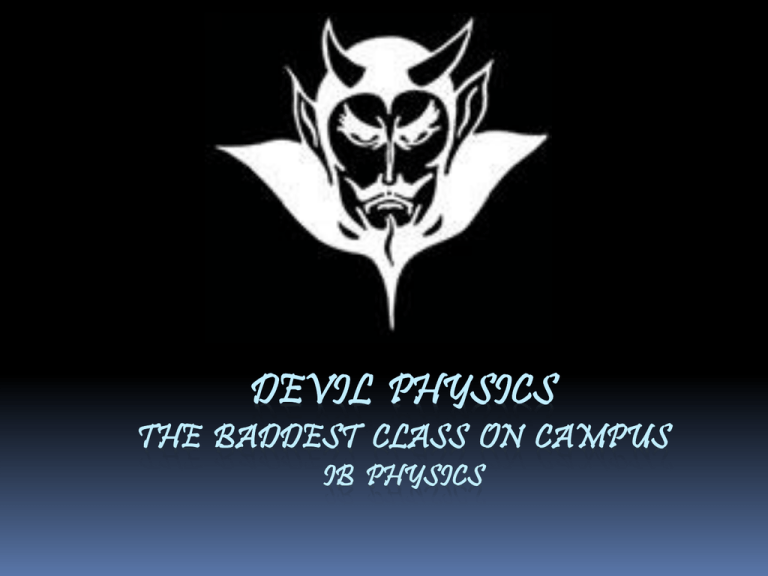
DEVIL PHYSICS THE BADDEST CLASS ON CAMPUS IB PHYSICS TSOKOS LESSON 6-2 THE LAW OF GRAVITATION Essential Idea: The Newtonian idea of gravitational force acting between two spherical bodies and the laws of mechanics create a model that can be used to calculate the motion of planets. Nature Of Science: Laws: Newton’s law of gravitation and the laws of mechanics are the foundation for deterministic classical physics. These can be used to make predictions but do not explain why the observed phenomena exist. Theory Of Knowledge: The laws of mechanics along with the law of gravitation create the deterministic nature of classical physics. Are classical physics and modern physics compatible? Do other areas of knowledge also have a similar division between classical and modern in their historical development? Understandings: Newton’s law of gravitation Gravitational field strength Applications And Skills: Describing the relationship between gravitational force and centripetal force Applying Newton’s law of gravitation to the motion of an object in circular orbit around a point mass Applications And Skills: Solving problems involving gravitational force, gravitational field strength, orbital speed and orbital period Determining the resultant gravitational field strength due to two bodies Guidance: Newton’s law of gravitation should be extended to spherical masses of uniform density by assuming that their mass is concentrated at their centre Gravitational field strength at a point is the force per unit mass experienced by a small point mass at that point Calculations of the resultant gravitational field strength due to two bodies will be restricted to points along the straight line joining the bodies Data Booklet Reference: Mm F G 2 r F g m M g G 2 r Utilization: The law of gravitation is essential in describing the motion of satellites, planets, moons and entire galaxies Comparison to Coulomb’s law (see Physics sub-topic 5.1) Aim 4: The theory of gravitation when combined and synthesized with the rest of the laws of mechanics allows detailed predictions about the future position and motion of planets Introductory Video The Force of Gravity Newton’s 2nd Law Newton’s second law (F=ma) implies that if a mass is accelerating, there must be a force acting on it An object falls (accelerates toward the earth) because of gravity What holds planets in their orbits? Newton’s 2nd Law Newton’s second law (F=ma) implies that if a mass is accelerating, there must be a force acting on it An object falls (accelerates toward the earth) because of gravity What holds planets in their orbits? Gravitational Force Newton’s Law of Gravitation The attractive force between two point masses is, Where, M 1M 2 F G 2 r M1 and M2 are the masses of the attracting bodies r is the distance between them G is Newton’s constant of universal gravitation and has a value of 6.667 x 10-11 N m2 kg-2 Newton’s Law of Gravitation The direction of the force is along the line joining the two masses, Newton’s Law of Gravitation The formula applies to point masses, which means the masses are small in relation to the separation between them Newton’s Law of Gravitation When the radii of two planets is small in comparison to the distance between them, we consider them to be point masses Newton’s Law of Gravitation What is the gravitational force between the earth and the sun? Newton’s Law of Gravitation What is the gravitational force between the earth and the sun? M 1M 2 F G 2 r FE S 3.5 x1022 N M E 5.98 x10 kg 24 M S 1.99 x10 30 kg r 1.5 x10 m 11 Newton’s Law of Gravitation How does this compare to the gravitational force between the earth and you? M 1M 2 F G 2 r FE S 3.5 x1022 N Newton’s Law of Gravitation How does this compare to the gravitational force between the earth and you? M 1M 2 F G 2 r FE S 3.5 x10 22 N FE You 7.35 x10 N 2 M E 5.98 x10 24 kg M You 75kg rE 3.38 x10 m 6 Newton’s Law of Gravitation Since F=ma, what value of a does this yield? M 1M 2 F G 2 r FE S 3.5 x10 22 N FE You 7.35 x10 N 2 Newton’s Law of Gravitation Since F=ma, what value of a does this yield? M 1M 2 F G r2 22 FE S 3.5 x10 N FE You 7.35 x10 2 N Sound Familiar? F ma F a m m you 75kg a 9.80 Gravitational Field Strength The gravitational field strength at a certain point is the force per unit mass experienced by a small point mass, m, at that point. M 1m F G 2 r F ma M 1m ma G 2 r M1 aG 2 r Gravitational Field Strength The units of gravitational field strength are Nkg-1 1N = 1 kg m s-2 So units become m s-2, acceleration! M 1m F G 2 r F ma M 1m ma G 2 r M1 a g G 2 r Gravitational Field Strength Gravitational field strength is a vector quantity whose direction is given by the direction of the force a point mass would experience if placed at the point of interest. Gravitational Field Strength The gravitational field strength around a single point mass is radial which means it is the same for all points equidistant from the center of mass and directed toward the center. Gravitational Field Strength On a micro- versus macro- level (like the projectile motion of a football), the field strength can be considered to be uniform with a constant value. The Law of Gravitation and Planetary Motion Orbital Motion In order for a body to move in a circular or elliptical path, there must be a force to cause centripetal acceleration For planets, that force is the force of gravity Mm F G 2 r 2 v F ma m r 2 v Mm m G 2 r r Orbital Motion Solving for v, we get the velocity a body must maintain to remain in an orbit 2 v Mm m G 2 r r GM 2 v r GM v r Orbital Motion GM v r 2r v T 2 2 4 r GM 2 T r 2 3 4 r 2 T GM 2 Using rotational velocity, we see that the square of the period is proportional to the cube of the distance between the two masses Orbital Motion From this we can develop a relationship between the orbits of two planets orbiting around the same central body (like the planets in our solar system orbiting the sun) 4 r T GM 2 2 T 4 3 r GM 2 2 T1 T2 3 3 r1 r2 2 3 2 Kepler and His Three Laws of Motion Understandings: Newton’s law of gravitation Gravitational field strength Data Booklet Reference: Mm F G 2 r F g m M g G 2 r Applications And Skills: Describing the relationship between gravitational force and centripetal force Applying Newton’s law of gravitation to the motion of an object in circular orbit around a point mass Applications And Skills: Solving problems involving gravitational force, gravitational field strength, orbital speed and orbital period Determining the resultant gravitational field strength due to two bodies Essential Idea: The Newtonian idea of gravitational force acting between two spherical bodies and the laws of mechanics create a model that can be used to calculate the motion of planets. QUESTIONS? Homework #15-25

